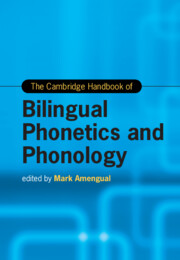Book contents
- The Cambridge Handbook of Bilingual Phonetics and Phonology
- Cambridge Handbooks in Language and Linguistics
- The Cambridge Handbook of Bilingual Phonetics and Phonology
- Copyright page
- Dedication
- Contents
- Figures
- Tables
- Contributors
- Acknowledgments
- Introduction Bilingual Phonetics and Phonology
- Part I Approaches to Bilingual Phonetics and Phonology
- Part II Theoretical Models of Bilingual Phonetics and Phonology
- Part III The Phonetics and Phonology of the Bilingual Child
- Part IV The Phonetics and Phonology of the Bilingual Adult
- Part V The Diversity of Bilingual Speakers
- Part VI Variables and Outcomes of Bilingual Speech
- 29 Language Dominance Effects in the Phonetics and Phonology of Bilinguals
- 30 Code-Switching and Language Mode Effects in the Phonetics and Phonology of Bilinguals
- 31 Orthographic Effects in the Phonetics and Phonology of Second Language Learners and Users
- 32 Phonetic and Phonological L1 Attrition and Drift in Bilingual Speech
- 33 Bilingual Speech Intelligibility
- 34 Using a Characteristic Speech Production (CSP) Procedure to Elicit Monolingual and Bilingual Speech
- 35 Bridging the Gap between Bilingual Phonetic Research and Pronunciation Teaching
- Index
- References
29 - Language Dominance Effects in the Phonetics and Phonology of Bilinguals
from Part VI - Variables and Outcomes of Bilingual Speech
Published online by Cambridge University Press: 14 November 2024
- The Cambridge Handbook of Bilingual Phonetics and Phonology
- Cambridge Handbooks in Language and Linguistics
- The Cambridge Handbook of Bilingual Phonetics and Phonology
- Copyright page
- Dedication
- Contents
- Figures
- Tables
- Contributors
- Acknowledgments
- Introduction Bilingual Phonetics and Phonology
- Part I Approaches to Bilingual Phonetics and Phonology
- Part II Theoretical Models of Bilingual Phonetics and Phonology
- Part III The Phonetics and Phonology of the Bilingual Child
- Part IV The Phonetics and Phonology of the Bilingual Adult
- Part V The Diversity of Bilingual Speakers
- Part VI Variables and Outcomes of Bilingual Speech
- 29 Language Dominance Effects in the Phonetics and Phonology of Bilinguals
- 30 Code-Switching and Language Mode Effects in the Phonetics and Phonology of Bilinguals
- 31 Orthographic Effects in the Phonetics and Phonology of Second Language Learners and Users
- 32 Phonetic and Phonological L1 Attrition and Drift in Bilingual Speech
- 33 Bilingual Speech Intelligibility
- 34 Using a Characteristic Speech Production (CSP) Procedure to Elicit Monolingual and Bilingual Speech
- 35 Bridging the Gap between Bilingual Phonetic Research and Pronunciation Teaching
- Index
- References
Summary
Researchers in bilingualism seek to identify factors that are associated with specific features of bilingual speech. One such predictive factor is language dominance, typically understood as the degree to which one of the languages of a bilingual is more often and more proficiently used. In this chapter we review landmark studies that demonstrate the power of language dominance in predicting fine-grained phonetic and phonological characteristics of speech production and on the perceptual and processing abilities in one or both languages of bilinguals. We then critically examine the construct of dominance and identify ways that dominance can be and has been measured, as well as challenges inherent in the measurement of dominance. We follow demonstrating the dynamic character of dominance by reviewing research on dominance switches and shifts. This is followed by a review of extant studies on language dominance in bilingual speech production, perception, and processing in both languages. We conclude with four areas where research can be fruitfully directed.
Keywords
- Type
- Chapter
- Information
- The Cambridge Handbook of Bilingual Phonetics and Phonology , pp. 655 - 676Publisher: Cambridge University PressPrint publication year: 2024

